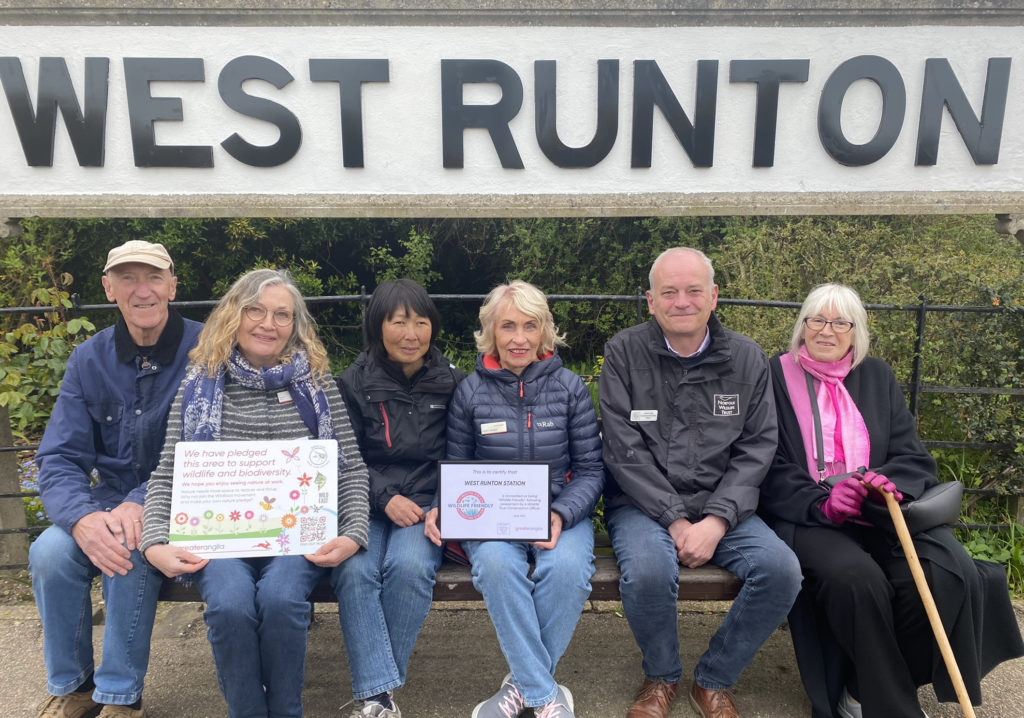Four rail stations in Norfolk have received a ‘Wildlife Friendly’ accreditation recognising the work of community volunteers to improve biodiversity and support nature.
Greater Anglia has partnered with Norfolk Wildlife Trust to formally recognise the achievements of its team of volunteer ‘station adopters’ to create wildlife havens at stations across its network through the new ‘Greater Anglia Wildlife Friendly Stations Accreditation Scheme.’
Brundall Gardens, Cantley, West Runton and Thetford stations became the first to receive the award this week, following assessment by a Norfolk Wildlife Trust Conservation Officer to determine how well they support local flora and fauna.
James Hogg, Norfolk Wildlife Trust’s Corporate and Membership Development Officer, said: “The alarming decline in the abundance of wildlife and the plight of species under threat means that just protecting the nature we have left is not enough; we need to put nature into recovery, and to do so at scale and with urgency. We are working to create a nature recovery network across Norfolk – and with fellow wildlife trusts across the UK – to create more space for wildlife.
“This project with Greater Anglia is a fantastic example of how people can transform nature-poor areas into new nature-rich places – and change the way we think about land, seizing opportunities to help nature outside traditional nature reserves.”

Each assessment also offers tips and advice for how to make the stations more wildlife friendly and the reports can also be used as examples of best practice to help spread good ideas around all Greater Anglia’s stations.
Greater Anglia’s Customer and Community Engagement Manager, Alan Neville, said, “We’re delighted to partner with the region’s wildlife trusts to formally recognise the valuable work of our station adopter volunteers in supporting wildlife and improving their local environment.”
“I’d like to congratulate the volunteers at these stations on receiving this recognition and thank them for the incredible work that are doing that makes each station a wonderful place to be, that is contributing to support biodiversity locally.”
Rail stations in East Anglia are increasingly becoming havens for local wildlife thanks to the efforts of volunteers who last year transformed over 6,800 square metres of land into thriving wildlife gardens.
In a recent survey, Greater Anglia station adopters reported a wide range of creatures visiting their stations including many different types of butterflies as well as bees, slow worms, bats, foxes, deer and many varieties of birds, recording more than 200 different species.
Greater Anglia has joined the rest of the rail industry in pledging to make stations across Britain more sustainable.
Action to reduce waste, support local wildlife and cut the carbon footprint of railway stations will be informed by the industry’s Sustainable Stations: Best Practice Guide, which details ways in which train operators can meet this commitment in support of global goals of decarbonisation, reducing waste and supporting local plant and animal life.
Norfolk Wildlife Trust’s vision for a Nature Recovery Network envisages a landscape in which nature reserves are connected by corridors of habitat, through which wild species and their genes flow freely. Crucially, people are also personally connected to wildlife and wild landscape, for their own wellbeing and for the benefit of nature.


